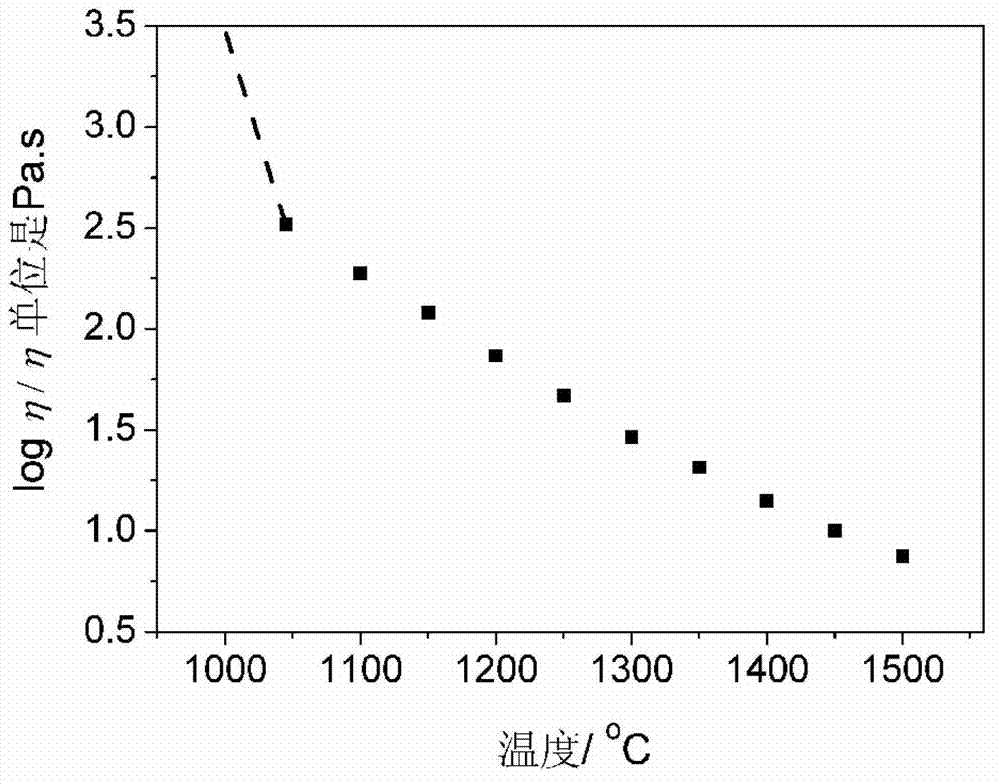Colored fluoride-free ceramic imitation azure stone
A fluorine imitation and color technology, applied in the field of colored fluorine-free imitation porcelain glaze, can solve the problems of uneven opacity degree, low dependence on cooling speed, limited application scope, etc. High degree of dependence, low cooling rate, and the effect of improving the degree of opacification
- Summary
- Abstract
- Description
- Claims
- Application Information
AI Technical Summary
Problems solved by technology
Method used
Image
Examples
Embodiment 1
[0035] The chemical composition mass percentage (wt%) of the clear material layer is:
[0036] SiO 2
al 2 o 3
B 2 o 3
Na 2 o
K 2 o
CaO
73.85
1.98
1.64
14.7
3.36
4.47
[0037] The mass percentage (wt%) of the chemical composition of the white material layer is:
[0038] SiO 2
Al 2 o 3
B 2 o 3
P 2 o 5
Na 2 o
K 2 o
CaO
BaO
60.7
3.5
1.0
6.1
13.6
3.7
2.9
8.5
[0039] The composition of raw materials used in the clear material layer is as follows: 74.6 parts of quartz sand, 1.01 parts of alumina, 1.45 parts of aluminum hydroxide, 2.89 parts of boric acid, 25.19 parts of soda ash, 5.02 parts of potassium carbonate, and 7.79 parts of calcite.
[0040] The parts by weight of the raw materials used in the white layer are: 60.22 parts of quartz sand, 2.53 parts of aluminum oxide, 1.85 par...
Embodiment 2
[0043] The chemical composition mass percentage (wt%) of the clear material layer is:
[0044] SiO 2
Al 2 o 3
B 2 o 3
Na 2 o
K 2 o
CaO
72.23
1.50
1.20
15.6
5.0
4.47
[0045] The mass percentage (wt%) of the chemical composition of the white material layer is:
[0046] SiO 2
Al 2 o 3
B 2 o 3
P 2 o 5
Na 2 o
K 2 o
CaO
BaO
58.3
3.20
1.0
6.2
15.5
4.2
3.1
8.5
[0047] The composition of raw materials used in the clear material layer is: 73.24 parts of quartz sand, 0.82 parts of alumina, 0.89 parts of aluminum hydroxide, 1.98 parts of boric acid, 26.73 parts of soda ash, 7.75 parts of potassium carbonate, and 8.19 parts of calcite.
[0048] The parts by weight of the raw materials used in the white layer are: 58.38 parts of quartz sand, 2.22 parts of aluminum oxide, 1.65 parts of alum...
Embodiment 3
[0051] The chemical composition mass percentage (wt%) of the clear material layer is:
[0052] SiO 2
al 2 o 3
B 2 o 3
Na 2 o
K 2 o
CaO
73.6
0.8
1.72
15.00
4.56
4.32
[0053] The mass percentage (wt%) of the chemical composition of the white material layer is:
[0054] SiO 2
al 2 o 3
B 2 o 3
P 2 o 5
Na 2 o
K 2 o
CaO
BaO
60.9
3.3
2.1
5.5
13.0
3.2
3.1
8.9
[0055] The composition of raw materials used in the clear material layer is as follows: 74.2 parts of quartz sand, 0.51 parts of alumina, 0.46 parts of aluminum hydroxide, 3.07 parts of boric acid, 26.45 parts of soda ash, 6.50 parts of potassium carbonate, and 8.05 parts of calcite.
[0056] The parts by weight of the raw materials used in the white layer are: 60.82 parts of quartz sand, 2.23 parts of aluminum oxide, 1.65 part...
PUM
| Property | Measurement | Unit |
|---|---|---|
| Thickness | aaaaa | aaaaa |
| Thickness | aaaaa | aaaaa |
| Thickness | aaaaa | aaaaa |
Abstract
Description
Claims
Application Information
 Login to View More
Login to View More - R&D
- Intellectual Property
- Life Sciences
- Materials
- Tech Scout
- Unparalleled Data Quality
- Higher Quality Content
- 60% Fewer Hallucinations
Browse by: Latest US Patents, China's latest patents, Technical Efficacy Thesaurus, Application Domain, Technology Topic, Popular Technical Reports.
© 2025 PatSnap. All rights reserved.Legal|Privacy policy|Modern Slavery Act Transparency Statement|Sitemap|About US| Contact US: help@patsnap.com


